What Should We Expect in the 2nd Half of 2019?
To be sure, Friday's jobs report created some uncertainty in terms of traders' Fed-expectations. While I can argue that the expectations regarding the degree and speed of anticipated rate cuts had gotten a little out of hand, the question of the day now becomes, what should we expect? As in what should we expect from Chairman Powell's dueling Congressional testimonies this week? What should we expect from the July Fed meeting? What should we expect from the upcoming earnings season, the economy, and inflation? And, of course, what should we expect from the stock and bond markets in the coming months?
If I have learned anything in my 32 years of professional investing, it is that trying to figure out what is going to happen next in Ms. Market's game with any degree of accuracy and/or consistency is a fool's errand. However, I have also learned that being prepared for what might/could happen next within a given time frame makes pulling the trigger on portfolio moves easier. In other words, if I have some idea of what is likely to happen, it is less emotionally taxing to make the necessary adjustments in a timely fashion.
It is for this reason that I make a habit of reviewing the stock market's historical cyclical patterns on a weekly basis. As the saying goes, history doesn't repeat itself, but it often rhymes. And I've found that oftentimes the stock market's seasonal tendencies will persist for some time.
Stock Market Cycles
Long-time readers know that I utilize a "cycle composite" in my work, which is the brainchild of the folks at Ned Davis Research Group. The analysts at NDR take all the one-year seasonal, four-year Presidential, and 10-year decennial cycles since 1900 and mash them up into a single composite. The cycle composite's projection for the year is then plotted on a chart to provide a graphical representation of what the historical cycles look like for the S&P 500 and the DJIA.
What I've found is that while no indicator can ever be expected to be perfect, when the S&P 500 is in sync with its historical cycles, the composite projection of what might happen next in the stock market can be good - as in, scary good.
Of course, there are times when Ms. Market zigs when she was projected to zag. Obviously, this is to be expected from time to time. And of course, there is no such thing as a crystal ball in this game. However, the cycle composite can be very helpful in terms of plotting out what might happen in the coming months.
For example, if I have some cash in a portfolio that needs to be put to work, knowing what the market has historically done in the coming months can make the decision of when to put the money to work easier. Again, nothing in this business is foolproof. But the cycle composite provides me with a sense of what the odds suggest could happen next. And it is for this reason, that I review the projections of the cycle composite on a weekly basis.
What the Cycles Say About the Rest of the Year
So, without further ado, let's take a peek at this year's cycle composite. In the chart below the blue line is the cycle composite's projection while the red dashed line is the action price action of the S&P 500...
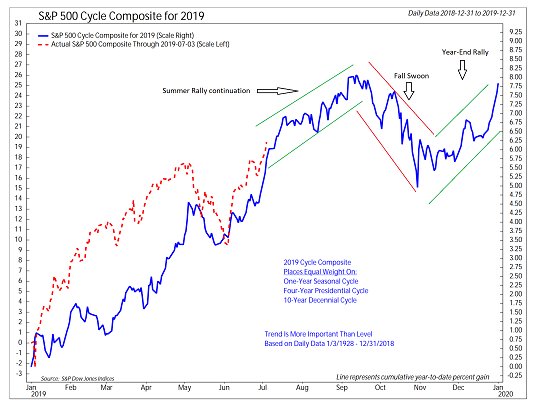
View Full Size Chart Online
Source: Ned Davis Research Group
The first thing to note about the current chart is that the S&P (red line) is currently almost exactly where the cycle composite projected it would be at this point in the year. Sure, the path of the index has diverged along the way. This is likely due to the Fed's quick pivot early in the year, which caused an equally violent "correction of the correction," erasing last December's dance to the downside in its entirety. However, May's correction and then June's rebound has managed to put the S&P back in sync with the cycle projection. Interesting.
So, what should we expect next? According to the cycle composite, the summer rally should continue into early September. And if Powell & Co. deliver the anticipated rate cut in this timespan, it is easy to see why the current joyride to the upside could continue.
From there, we may get a "fall swoon" lasting into late October, which would be followed by the traditional year-end rally - taking the index back toward the highs of the year.
My Takeaway
What this tells me is that while stocks are overbought currently, the bulls might still have some gas left in the tank. So, we shouldn't be too surprised if stocks continue to rally this month and next. However, the cycle composite also suggests that there may be a pretty good buying opportunity during the next pullback.
Of course, if Jay Powell decides to walk back expectations for a July rate-cut this week on Capitol Hill, the cycle projection could become useless in the near-term. Such is the case with news-driven environments.
But if Ms. Market continues to stick to the script, I for one will be looking to buy the next dip in anticipation of a strong run into the end of the year and the seasonally strong start to new calendar years. Fingers crossed!
Weekly Market Model Review
Now let's turn to the weekly review of my favorite indicators and market models...
The State of My Favorite Big-Picture Market Models
The Primary Cycle board continues to improve as the readings of the individual models moved higher again last week. So, while an inevitable pullback is to be expected in the coming days/weeks, this board tells us to look at any weakness as an opportunity to add exposure.
This week's mean percentage score of my 6 favorite models improved to 81.1% from 73.5% last week (Prior readings: 62.9%, 65.4%, 62.9%, 60%, 60%, 72.5%) while the median also rose to 82.5% versus 68.5% last week (Prior readings: 66.3%, 71.3%, 68.8%, 62.5%, 62.5%, 80.0% 82.5%).
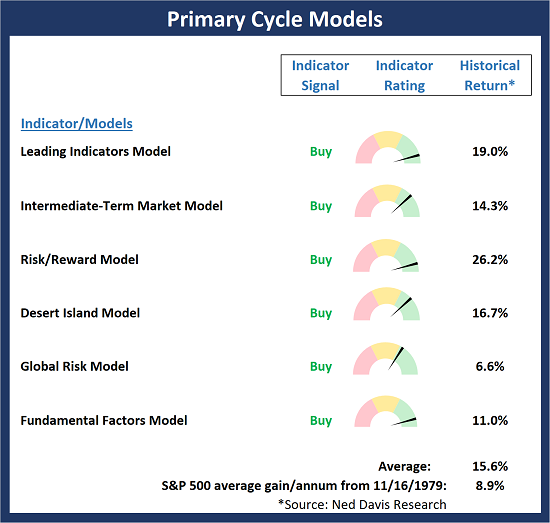
View My Favorite Market Models Online
The State of the Fundamental Backdrop
The fact that the component indicators within the Fundamental board continues to improve, tells me to give the bulls the benefit of any doubt and to buy the inevitable dips. I will continue to monitor the monetary, earnings and valuation models closely for any signs of deterioration. But so far, so good.
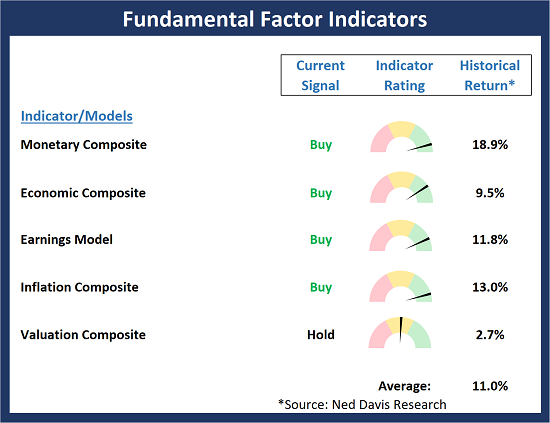
View Fundamental Indicator Board Online
The State of the Trend
Yes, this remains a news-driven environment, especially from a short-term perspective. And yes, Jay Powell could certainly provide a reason for some profit-taking if he even hints at walking back rate cuts this week. But from a purely technical perspective, investors need to recognize that the trend is their friend and the trend indicators are about as positive as they can be at the current time. So, again, "buy the dips" would appear to be an appropriate battle cry here.
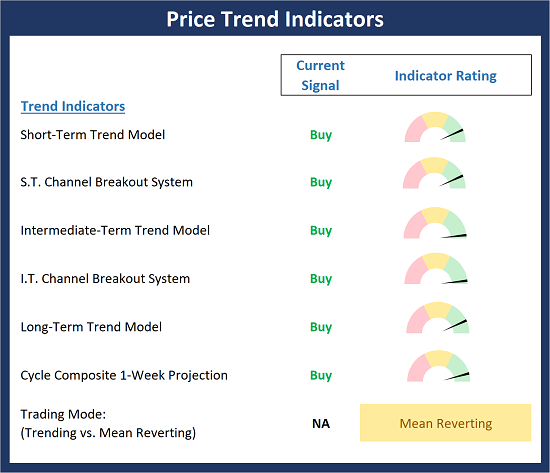
View Trend Indicator Board Online
The State of Internal Momentum
The Momentum board remains in very good shape. However, I will admit that the board is not in a "pound the table" mode at the present time. This tells me that while it is fine to be invested, it may not be the time to "put the hammer down" in terms of how aggressive portfolios should be positioned at the present time.
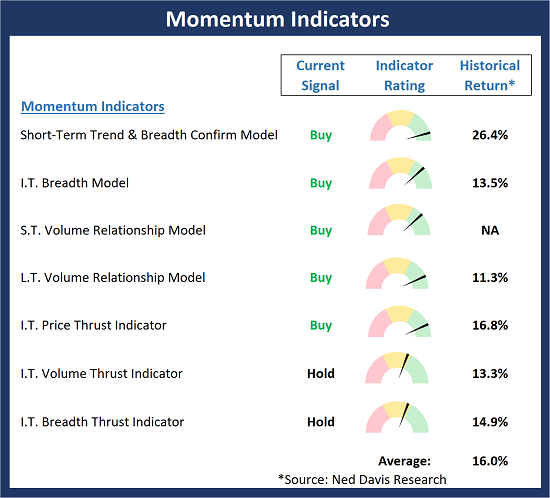
View Momentum Indicator Board Online
The State of the "Trade"
While the changes to the Early Warning board are nuanced and somewhat hard to see, it looks to me that the board is moving toward a bearish setup from a short-term trading perspective. Although the table is not yet set nicely for our furry friends in the bear camp, I believe it is important to be ready/looking for the next pullback.
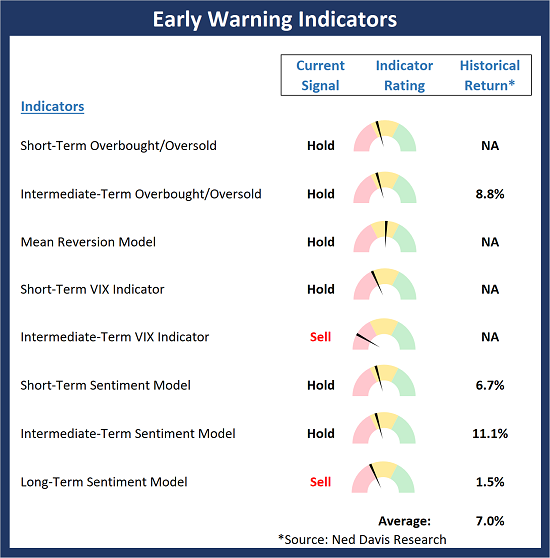
View Early Warning Indicator Board Online
Thought For The Day:
You can't base your life on other people's expectations. -Stevie Wonder
Wishing you green screens and all the best for a great day,

David D. Moenning
Founder, Chief Investment Officer
Heritage Capital Research
HCR Focuses on a Risk-Managed Approach to Investing
What Risk Management Can and Cannot Do
Disclosures
At the time of publication, Mr. Moenning held long positions in the following securities mentioned: None - Note that positions may change at any time.
Leading Indicators Model: A group of indicators that have historically shown tendencies to lead the market at major turning points.
Intermediate-Term Market Model: A composite model (model of models) focused on trend and momentum indicators which has been designed to provide identify intermediate-term trading opportunities.
Risk/Reward Model: A model-of-models intended to provide an overall view of the state of the risk/reward environment. The model includes tape, monetary, and sentiment indicators as well as 7 big-picture market model readings.
Desert Island Model: If I was stranded on a desert island with access to only one market model to manage money with, this would be the model. The model is a comprehensive model-of-models comprised of trend, momentum, mean reversion, economic, monetary, sentiment, and factor-based indicators/models.
External Factors Model: A model-of-models designed to provide a reading on the "macro state" of the market environment. The model is comprised of indicators/models in the areas of various index yields, industrial production, investors sentiment, and historic volatility.
Short-Term Trend-and-Breadth Signal Explained: History shows the most reliable market moves tend to occur when the breadth indices are in gear with the major market averages. When the breadth measures diverge, investors should take note that a trend reversal may be at hand. This indicator incorporates NDR's All-Cap Dollar Weighted Equity Series and A/D Line. From 1998, when the A/D line is above its 5-day smoothing and the All-Cap Equal Weighted Equity Series is above its 25-day smoothing, the equity index has gained at a rate of +32.5% per year. When one of the indicators is above its smoothing, the equity index has gained at a rate of +13.3% per year. And when both are below, the equity index has lost +23.6% per year.
Channel Breakout System Explained: The short-term and intermediate-term Channel Breakout Systems are modified versions of the Donchian Channel indicator. According to Wikipedia, "The Donchian channel is an indicator used in market trading developed by Richard Donchian. It is formed by taking the highest high and the lowest low of the last n periods. The area between the high and the low is the channel for the period chosen."
Intermediate-Term Trend-and-Breadth Signal Explained: This indicator incorporates NDR's All-Cap Dollar Weighted Equity Series and A/D Line. From 1998, when the A/D line is above its 45-day smoothing and the All-Cap Equal Weighted Equity Series is above its 45-day smoothing, the equity index has gained at a rate of +17.6% per year. When one of the indicators is above its smoothing, the equity index has gained at a rate of +6.5% per year. And when both are below, the equity index has lost -1.3% per year.
Cycle Composite Projections: The cycle composite combines the 1-year Seasonal, 4-year Presidential, and 10-year Decennial cycles. The indicator reading shown uses the cycle projection for the upcoming week.
Trading Mode Indicator: This indicator attempts to identify whether the current trading environment is "trending" or "mean reverting." The indicator takes the composite reading of the Efficiency Ratio, the Average Correlation Coefficient, and Trend Strength models.
Volume Relationship Models: These models review the relationship between "supply" and "demand" volume over the short- and intermediate-term time frames.
Price Thrust Model Explained: This indicator measures the 3-day rate of change of the Value Line Composite relative to the standard deviation of the 30-day average. When the Value Line's 3-day rate of change have moved above 0.5 standard deviation of the 30-day average ROC, a "thrust" occurs and since 2000, the Value Line Composite has gained ground at a rate of +20.6% per year. When the indicator is below 0.5 standard deviation of the 30-day, the Value Line has lost ground at a rate of -10.0% per year. And when neutral, the Value Line has gained at a rate of +5.9% per year.
Volume Thrust Model Explained: This indicator uses NASDAQ volume data to indicate bullish and bearish conditions for the NASDAQ Composite Index. The indicator plots the ratio of the 10-day total of NASDAQ daily advancing volume (i.e., the total volume traded in stocks which rose in price each day) to the 10-day total of daily declining volume (volume traded in stocks which fell each day). This ratio indicates when advancing stocks are attracting the majority of the volume (readings above 1.0) and when declining stocks are seeing the heaviest trading (readings below 1.0). This indicator thus supports the case that a rising market supported by heavier volume in the advancing issues tends to be the most bullish condition, while a declining market with downside volume dominating confirms bearish conditions. When in a positive mode, the NASDAQ Composite has gained at a rate of +38.3% per year, When neutral, the NASDAQ has gained at a rate of +13.3% per year. And when negative, the NASDAQ has lost at a rate of -14.279% per year.
Breadth Thrust Model Explained: This indicator uses the number of NASDAQ-listed stocks advancing and declining to indicate bullish or bearish breadth conditions for the NASDAQ Composite. The indicator plots the ratio of the 10-day total of the number of stocks rising on the NASDAQ each day to the 10-day total of the number of stocks declining each day. Using 10-day totals smooths the random daily fluctuations and gives indications on an intermediate-term basis. As expected, the NASDAQ Composite performs much better when the 10-day A/D ratio is high (strong breadth) and worse when the indicator is in its lower mode (weak breadth). The most bullish conditions for the NASDAQ when the 10-day A/D indicator is not only high, but has recently posted an extreme high reading and thus indicated a thrust of upside momentum. Bearish conditions are confirmed when the indicator is low and has recently signaled a downside breadth thrust. In positive mode, the NASDAQ has gained at a rate of +22.1% per year since 1981. In a neutral mode, the NASDAQ has gained at a rate of +14.5% per year. And when in a negative mode, the NASDAQ has lost at a rate of -6.4% per year.
Short-Term Overbought/sold Indicator: This indicator is the current reading of the 14,1,3 stochastic oscillator. When the oscillator is above 80 and the %K is above the %D, the indicator gives an overbought reading. Conversely, when the oscillator is below 20 and %K is below its %D, the indicator is oversold.
Intermediate-Term Overbought/sold Indicator: This indicator is a 40-day RSI reading. When above 57.5, the indicator is considered overbought and wnen below 45 it is oversold.
Mean Reversion Model: This is a diffusion model consisting of five indicators that can produce buy and sell signals based on overbought/sold conditions.
VIX Indicator: This indicators looks at the current reading of the VIX relative to standard deviation bands. When the indicator reaches an extreme reading in either direction, it is an indication that a market trend could reverse in the near-term.
Short-Term Sentiment Indicator: This is a model-of-models composed of 18 independent sentiment indicators designed to indicate when market sentiment has reached an extreme from a short-term perspective. Historical analysis indicates that the stock market's best gains come after an environment has become extremely negative from a sentiment standpoint. Conversely, when sentiment becomes extremely positive, market returns have been subpar.
Intermediate-Term Sentiment Indicator: This is a model-of-models composed of 7 independent sentiment indicators designed to indicate when market sentiment has reached an extreme from a intermediate-term perspective. Historical analysis indicates that the stock market's best gains come after an environment has become extremely negative from a sentiment standpoint. Conversely, when sentiment becomes extremely positive, market returns have been subpar.
Long-Term Sentiment Indicator: This is a model-of-models composed of 6 independent sentiment indicators designed to indicate when market sentiment has reached an extreme from a long-term perspective. Historical analysis indicates that the stock market's best gains come after an environment has become extremely negative from a sentiment standpoint. Conversely, when sentiment becomes extremely positive, market returns have been subpar.
Absolute Monetary Model Explained: The popular cliche, "Don't fight the Fed" is really a testament to the profound impact that interest rates and Fed policy have on the market. It is a proven fact that monetary conditions are one of the most powerful influences on the direction of stock prices. The Absolute Monetary Model looks at the current level of interest rates relative to historical levels and Fed policy.
Relative Monetary Model Explained: The "relative" monetary model looks at monetary indicators relative to recent levels as well as rates of change and Fed Policy.
Economic Model Explained: During the middle of bull and bear markets, understanding the overall health of the economy and how it impacts the stock market is one of the few truly logical aspects of the stock market. When our Economic model sports a "positive" reading, history (beginning in 1965) shows that stocks enjoy returns in excess of 21% per year. Yet, when the model's reading falls into the "negative" zone, the S&P has lost nearly -25% per year. However, it is vital to understand that there are times when good economic news is actually bad for stocks and vice versa. Thus, the Economic model can help investors stay in tune with where we are in the overall economic cycle.
Inflation Model Explained: They say that "the tape tells all." However, one of the best "big picture" indicators of what the market is expected to do next is inflation. Simply put, since 1962, when the model indicates that inflationary pressures are strong, stocks have lost ground. Yet, when inflationary pressures are low, the S&P 500 has gained ground at a rate in excess of 13%. The bottom line is inflation is one of the primary drivers of stock market returns.
Valuation Model Explained: If you want to get analysts really riled up, you need only to begin a discussion of market valuation. While the question of whether stocks are overvalued or undervalued appears to be a simple one, the subject is actually extremely complex. To simplify the subject dramatically, investors must first determine if they should focus on relative valuation (which include the current level of interest rates) or absolute valuation measures (the more traditional readings of Price/Earnings, Price/Dividend, and Price/Book Value). We believe that it is important to recognize that environments change. And as such, the market's focus and corresponding view of valuations are likely to change as well. Thus, we depend on our Valuation Models to help us keep our eye on the ball.
Disclosures
NOT INVESTMENT ADVICE. The opinions and forecasts expressed herein are those of Mr. David Moenning and Heritage Capital Research and may not actually come to pass. The opinions and viewpoints regarding the future of the markets should not be construed as recommendations. The analysis and information in this report is for informational purposes only. No part of the material presented in this report is intended as an investment recommendation or investment advice. Neither the information nor any opinion expressed constitutes a solicitation to purchase or sell securities or any investment program.
Any investment decisions must in all cases be made by the reader or by his or her investment adviser. Do NOT ever purchase any security without doing sufficient research. There is no guarantee that the investment objectives outlined will actually come to pass. All opinions expressed herein are subject to change without notice. Neither the editor, employees, nor any of their affiliates shall have any liability for any loss sustained by anyone who has relied on the information provided.
Mr. Moenning of Heritage Capital Research is an investment adviser representative of Eastsound Capital Advisors, LLC, a registered investment advisor. The adviser may not transact business in states where it is not appropriately registered, excluded or exempted from registration. Individualized responses to persons that involve either the effecting of transaction in securities, or the rendering of personalized investment advice for compensation, will not be made without registration or exemption.
Mr. Moenning and Heritage Capital Research may at times have positions in the securities referred to and may make purchases or sales of these securities while publications are in circulation. Positions may change at any time.
The analysis provided is based on both technical and fundamental research and is provided "as is" without warranty of any kind, either expressed or implied. Although the information contained is derived from sources which are believed to be reliable, they cannot be guaranteed.
The author neither endorses nor warrants the content of this site, any embedded advertisement, or any linked resource. The author or his managed funds may hold either long or short positions in the referenced securities. Republication rights must be expressly granted by author in writing.
Investments in equities carry an inherent element of risk including the potential for significant loss of principal. Past performance is not an indication of future results.

